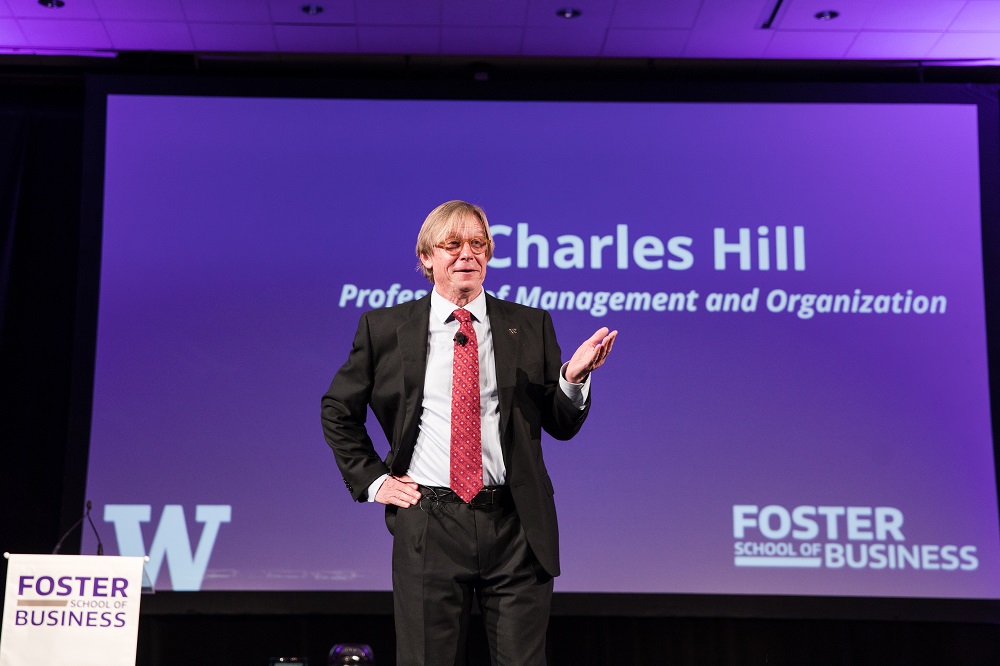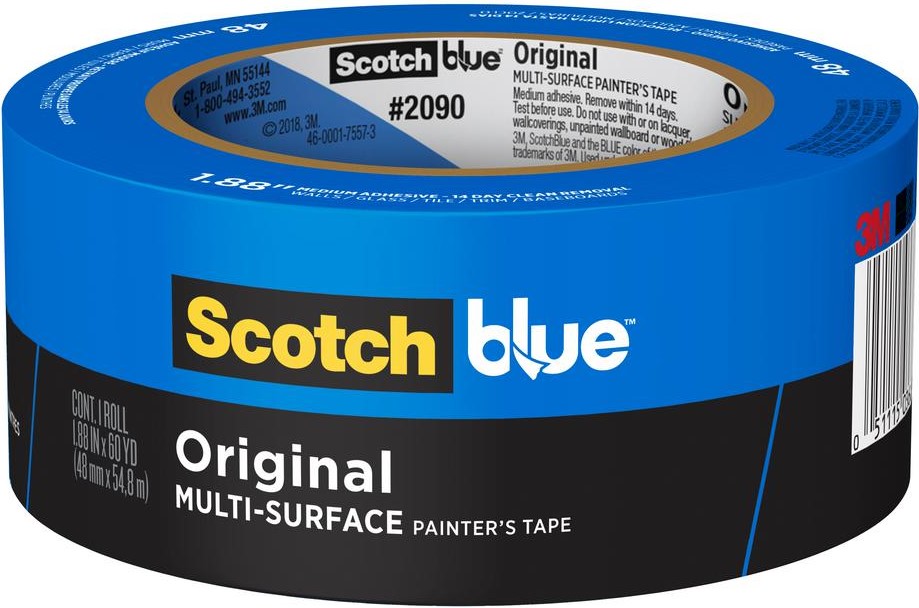BLC 2019: A Charles Hill leadership lesson embedded in a story of grit
 Sandpaper. It’s not a topic you might expect to light up an audience of several hundred movers and shakers in attendance at the UW Foster School’s 28th annual Business Leadership Celebration.
Sandpaper. It’s not a topic you might expect to light up an audience of several hundred movers and shakers in attendance at the UW Foster School’s 28th annual Business Leadership Celebration.
Yet it was humble sandpaper that made for an unexpectedly intriguing entrée to a captivating lesson on leadership made indelible by Charles Hill, the charismatic professor of management and strategy at the Foster School.
Here is the text of Hill’s micro-lecture:
The story I’m going to tell you is about sandpaper. I know the topic sounds boring. It goes back to the 1920s. It’s a story about a man called William McKnight and another man called Richard Drew. William McKnight was 29 years old and had just been named president of a small, nearly bankrupt company in Minneapolis called Minnesota Mining and Manufacturing.
He had just licensed a new kind of sandpaper called “Wetordry” sandpaper. And he immediately recognized the value of this product. It had a very fine grit, you could put it in water, and use it to sand things without sending dust residue into the atmosphere. You could then wipe off the dust when it dried. And it would be really good for a paint job in, let’s say, an Oldsmobile body shop.
He had licensed this product. But they had a problem with it: the grit did not stick to the paper. And that’s a problem if you want a nice, smooth paint job.
He realized they had to have a better adhesive to bind the grit to the paper. So he hired a scientist, a 22 year-old named Richard Drew who had just graduated from the University of Minnesota with an undergraduate degree in chemistry. And he told Mr. Drew, “I need you to make a better adhesive. And I’m going to give you a lab.”
Eureka by mistake
So, Mr. Drew went into the lab and experimented with all different kinds of adhesive. And by mistake, he made a weak adhesive. But this gave him an idea. Because he’d been in auto body shops and saw how people were using 3M Wetordry sandpaper and saw they had a problem. The problem was that they were trying to do a two-tone paint job on the cars. But the paint would run over the lines.
He had an epiphany. “By mistake, I’ve made this weak adhesive, which has a very interesting property. You put it on the back of a strip of paper and stick it on the car and then peel it off after the paint has dried—and the adhesive will stick to the paper, it doesn’t remain on the surface you adhered it to. This is a brilliant idea!”
 So, the first thing he did was to go see Mr. McKnight. He told his boss, “I’ve been working on a stronger adhesive. I’ve done all sorts of different experiments and I haven’t quite cracked this problem yet. But by mistake, I’ve developed a weak adhesive. And I think it could be really useful. I think we could use it to make a new product: masking tape.”
So, the first thing he did was to go see Mr. McKnight. He told his boss, “I’ve been working on a stronger adhesive. I’ve done all sorts of different experiments and I haven’t quite cracked this problem yet. But by mistake, I’ve developed a weak adhesive. And I think it could be really useful. I think we could use it to make a new product: masking tape.”
And William McNight goes, “What the hell are you talking about? I hired you for a particular reason: to make a strong adhesive to fix a problem with our product. Go back to your lab and do it!”
Testing the market
So, this 22-year-old has been puppy smacked. He goes back to the lab, tail between his legs. But he cannot get this idea out of his mind. He keeps thinking about this weak adhesive and the potential it has.
After everyone goes home from the lab, Richard Drew keeps refining this weak adhesive and develops test batches. And he decides to go visit some customers, and see what they would say about this new product.
The customers are euphoric. This is exactly what we’ve been looking for. This is what we need!
They’re so excited about the product that they place orders. Which is a problem for Drew, because his boss told him not to work on it.
So now he has to confess. He picks up his courage and knocks on Mr. McKnight’s door and says, “I have to tell you something. I was working on that weak adhesive—I couldn’t get it out of my mind—and I developed test batches and showed it to some customers and, uh, we’ve got orders.”
Taking a chance
This is a pivotal moment in the history of 3M. What McKnight could have said is, “I told you not to do that. You committed resources and have taken orders for a product that we don’t actually make. You’re fired.”
But that’s not what McKnight did. What McKnight said is, “You’re right. I’ve been a fool. We’re nearly bankrupt. We need cash flow. Of course we should do this! Why didn’t I realize this first time around? And by the way, go back to your lab and make a strong adhesive.”
Which Drew did.
 Now, why is this interesting? First of all, 3M did not have a strategy for getting into the tape business. (It’s now, by the way, the world’s largest manufacturer of tape—any kind of tape you can think of: duct tape, scotch tape, surgical tape, you name it, they make it.)
Now, why is this interesting? First of all, 3M did not have a strategy for getting into the tape business. (It’s now, by the way, the world’s largest manufacturer of tape—any kind of tape you can think of: duct tape, scotch tape, surgical tape, you name it, they make it.)
It wasn’t the strategy. It wasn’t planned. It wasn’t top-down. It wasn’t the result of a SWOT analysis. They didn’t bring in expensive consultants to tell them what to do. A 22-year-old had an idea, and that idea became a product.
Institutionalizing inspiration & innovation
More importantly, Richard Drew and William McKnight sat down afterward and said, “Okay, this is interesting. How can we make this repeatable? How can we do this time and time and time again?”
And they came up with a number of rules and institutions within 3M. First is the 15 percent rule—scientists can spend 15 percent of their time on any job, any project they want to—and top management cannot stop them. Second, the first review on a new product is by your peers, not by management (because what did McKnight try to do? Stop it.). And third, even if management doesn’t fund you, they establish different pools of financing within 3M so that if you get refused by one channel you can go to another. You can shop your product around to different divisions. And there are many other policies that they put into place.
So, what does this have to do with leadership? One of the crucial jobs of leadership is to establish the content which allows other people within an organization to fulfill their potential. And that’s what Mr. McKnight and Mr. Drew did through their design of the organization.
By the way, William McKnight became the CEO and chairman of 3M and was there until the 1950s, and Richard Drew became the chief technology officer. They were two of the three or four people who built 3M from the ground up and established the institutions within the organization that allowed it to become the innovation colossus that it is today.
And that’s how you get from one product—sandpaper—to 50,000 products, which is what 3M has today.
